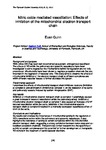Nitric oxide mediated vasodilation: Effects of inhibition of the mitochondrial electron transport chain
| dc.contributor.author | Gunn, E. | |
| dc.date.accessioned | 2019-05-15T14:56:14Z | |
| dc.date.available | 2019-05-15T14:56:14Z | |
| dc.date.issued | 2013 | |
| dc.identifier.citation |
Gunn, E. (2013) 'Nitric oxide mediated vasodilation: Effects of inhibition of the mitochondrial electron transport chain', The Plymouth Student Scientist, 6(1), p. 16-31. | en_US |
| dc.identifier.issn | 1754-2383 | |
| dc.identifier.uri | http://hdl.handle.net/10026.1/14006 | |
| dc.description.abstract |
Background and purpose Nitric oxide (NO) has been well documented as a potent, endogenous vasodilator. The effects of NO within the pulmonary and systemic vasculature have been investigated to some degree but the mechanisms behind its regulation are not fully understood. Mitochondria have been shown to regulate potassium channels that are important in the regulation of vascular tone. This study aims to observe the effects of mitochondrial inhibition of the electron transport chain at different complexes and within different vascular tissues to further elucidate this system. Experimental approach I examined the effects of mitochondrial transport chain inhibitors rotenone (inhibition at complex 3) and antimysin-A (inhibition at complex 1) on the relaxation of rat aortic and pulmonary vessels, induced by sodium nitroprusside (SNP). Key results Inhibition of mitochondrial electron transport chain at complex 1 surprisingly caused a great increase in levels of vasodilation within the pulmonary artery. Inhibition of mitochondrial electron transport chain at complex 1 also caused an increase of SNP induced vasodilation within the aorta. Inhibition of the mitochondrial electron transport chain at complex 3 resulted in a markedly decreased vasodilatory effect of SNP on the aorta. Conclusions and implications My results demonstrate the importance of mitochondrial activity in the regulation of NO's vasodilator action within the pulmonary and systemic vasculature. It also highlights the relevance of activity at certain complexes within the mitochondrial electron transport chain, suggesting a strong correlation between redox state and co-localised potassium channels. This promotes further research into the specificity of activity at certain complexes and the potential for further development of therapeutic NO donors in the treatment of cardiovascular disorders. | en_US |
| dc.language.iso | en | en_US |
| dc.publisher | University of Plymouth | |
| dc.rights | Attribution 3.0 United States | * |
| dc.rights.uri | http://creativecommons.org/licenses/by/3.0/us/ | * |
| dc.subject | Nitric oxide | en_US |
| dc.subject | endogenous vasodilator | en_US |
| dc.subject | pulmonary and systemic vasculature | en_US |
| dc.subject | potassium channels | en_US |
| dc.subject | mitochondrial transport | en_US |
| dc.subject | cardiovascular disorders | en_US |
| dc.title | Nitric oxide mediated vasodilation: Effects of inhibition of the mitochondrial electron transport chain | en_US |
| dc.type | Article | |
| plymouth.issue | 1 | |
| plymouth.volume | 6 | |
| plymouth.journal | The Plymouth Student Scientist |



